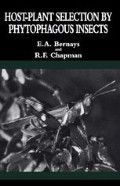Abstract
A continuous spectrum exists between insect species that will only feed on one plant species and others that feed on a very wide range of plants in many different families. It is usual to separate the insects into categories depending on their host-plant ranges, but it is important to recognize that no clear boundaries separate these groups and different authors use them in different ways. The categories commonly recognized are: monophagous, oligophagous and polyphagous.
Access this chapter
Tax calculation will be finalised at checkout
Purchases are for personal use only
Preview
Unable to display preview. Download preview PDF.
References
Bernays, E.A., Chapman, R.F., Macdonald, J. and Salter, J.E.R. 1976. The degree of oligophagy in Locusta migratoria (L.). Ecol.Entomol. 1: 223–230.
Chapman, R.F. 1982. Chemoreception: the significance of receptor numbers. Adv.Insect Physiol. 16: 247–356.
Chapman, R.F., Bernays, E.A. and Wyatt, T. 1988. Chemical aspects of host-plant specificity in three Larrea-feeding grasshoppers. J.Chem.Ecol. 14: 561–579.
Hsiao, T.H. 1978. Host plant adaptations among geographic populations of the Colorado potato beetle. Entomologia Exp.Appl. 24: 437–447.
Hsiao, T.H. 1988. Host specificity, seasonality and bionomics of Leptinotarsa beetles. In Jolivet, P., Petitpierre, E. and Hsiao, T.H. (eds.) Biology of Chrysomelidae. Kluwer, pp. 581–599.
Morris, M.G. 1990. Orthocerous weevils. Handbooks for the Identification of British Insects, vol. 5, part 16. Royal Entomological Society of London.
Smiley, J.T. 1978. Plant chemistry and the evolution of host specificity. New evidence from Heliconius and Passiflora. Science 201: 745–747.
Wiklund, C. 1982. Generalist versus specialist utilization of host plants among butterflies. In Visser, J.H. and Minks, A.K. (eds.) Insect-Plant Relationships. Pudoc, Wageningen, pp. 181–191.
Further Reading
Eastop, V.F. 1973. Deductions from the present day host plants of aphids and related insects. Symp.R.Entomol.Soc.Lond. 6: 157–178.
Eastop, V.F. 1973. Diversity of the Sternorrhyncha within major climatic zones. Symp.R.Entomol.Soc. Lond. 9: 71–88.
Fox, L.R. and Morrow, P. A. 1981. Specialization: species property or local phenomenon? Science 211: 887–893.
Strong, D.R., Lawton, J.H. and Southwood, R. 1984. Insects on Plants. Harvard, Cambridge.
Rights and permissions
Copyright information
© 1994 Chapman & Hall, New York, NY
About this chapter
Cite this chapter
(1994). Patterns of Host-Plant Use. In: Host-Plant Selection by Phytophagous Insects. Contemporary Topics in Entomology, vol 2. Springer, Boston, MA. https://doi.org/10.1007/978-0-585-30455-7_2
Download citation
DOI: https://doi.org/10.1007/978-0-585-30455-7_2
Publisher Name: Springer, Boston, MA
Print ISBN: 978-0-412-03131-1
Online ISBN: 978-0-585-30455-7
eBook Packages: Springer Book Archive

